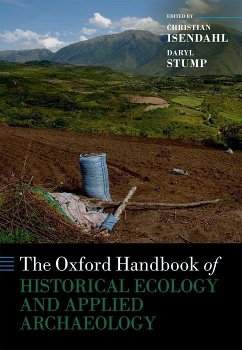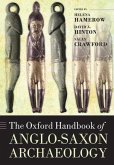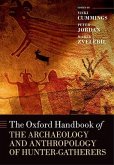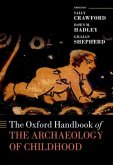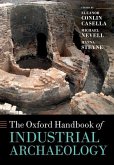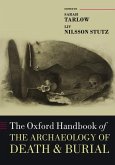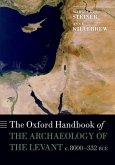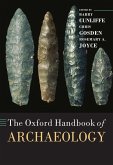The Oxford Handbook of Historical Ecology and Applied Archaeology
Herausgeber: Isendahl, Christian; Stump, Daryl
The Oxford Handbook of Historical Ecology and Applied Archaeology
Herausgeber: Isendahl, Christian; Stump, Daryl
- Gebundenes Buch
- Merkliste
- Auf die Merkliste
- Bewerten Bewerten
- Teilen
- Produkt teilen
- Produkterinnerung
- Produkterinnerung
Historical ecology is based on the recognition that humans are not only capable of modifying their environments, but that all environments on earth have already been directly or indirectly modified. This Handbook provides examples of how people interact with their environments and presents outlines of the methods used to understand these changes.
Andere Kunden interessierten sich auch für
![The Oxford Handbook of Anglo-Saxon Archaeology The Oxford Handbook of Anglo-Saxon Archaeology]() The Oxford Handbook of Anglo-Saxon Archaeology62,99 €
The Oxford Handbook of Anglo-Saxon Archaeology62,99 €![The Oxford Handbook of the Archaeology and Anthropology of Hunter-Gatherers The Oxford Handbook of the Archaeology and Anthropology of Hunter-Gatherers]() The Oxford Handbook of the Archaeology and Anthropology of Hunter-Gatherers76,99 €
The Oxford Handbook of the Archaeology and Anthropology of Hunter-Gatherers76,99 €![The Oxford Handbook of the Archaeology of Childhood The Oxford Handbook of the Archaeology of Childhood]() The Oxford Handbook of the Archaeology of Childhood200,99 €
The Oxford Handbook of the Archaeology of Childhood200,99 €![The Oxford Handbook of Industrial Archaeology The Oxford Handbook of Industrial Archaeology]() The Oxford Handbook of Industrial Archaeology215,99 €
The Oxford Handbook of Industrial Archaeology215,99 €![The Oxford Handbook of the Archaeology of Death & Burial The Oxford Handbook of the Archaeology of Death & Burial]() The Oxford Handbook of the Archaeology of Death & Burial62,99 €
The Oxford Handbook of the Archaeology of Death & Burial62,99 €![The Oxford Handbook of the Archaeology of the Levant The Oxford Handbook of the Archaeology of the Levant]() The Oxford Handbook of the Archaeology of the Levant63,99 €
The Oxford Handbook of the Archaeology of the Levant63,99 €![The Oxford Handbook of Archaeology The Oxford Handbook of Archaeology]() The Oxford Handbook of Archaeology63,99 €
The Oxford Handbook of Archaeology63,99 €-
-
-
Historical ecology is based on the recognition that humans are not only capable of modifying their environments, but that all environments on earth have already been directly or indirectly modified. This Handbook provides examples of how people interact with their environments and presents outlines of the methods used to understand these changes.
Hinweis: Dieser Artikel kann nur an eine deutsche Lieferadresse ausgeliefert werden.
Hinweis: Dieser Artikel kann nur an eine deutsche Lieferadresse ausgeliefert werden.
Produktdetails
- Produktdetails
- Oxford Handbooks
- Verlag: Oxford University Press
- Seitenzahl: 656
- Erscheinungstermin: 11. März 2019
- Englisch
- Abmessung: 253mm x 185mm x 42mm
- Gewicht: 1478g
- ISBN-13: 9780199672691
- ISBN-10: 0199672695
- Artikelnr.: 54319996
- Herstellerkennzeichnung
- Libri GmbH
- Europaallee 1
- 36244 Bad Hersfeld
- gpsr@libri.de
- Oxford Handbooks
- Verlag: Oxford University Press
- Seitenzahl: 656
- Erscheinungstermin: 11. März 2019
- Englisch
- Abmessung: 253mm x 185mm x 42mm
- Gewicht: 1478g
- ISBN-13: 9780199672691
- ISBN-10: 0199672695
- Artikelnr.: 54319996
- Herstellerkennzeichnung
- Libri GmbH
- Europaallee 1
- 36244 Bad Hersfeld
- gpsr@libri.de
Christian Isendahl is Senior Lecturer in Archaeology at the Department of Historical Studies, University of Gothenburg, Sweden. He is interested in issues of long-term sustainability and resilience, and applies a historical ecological lens to study urbanism, farming systems, water management, and socio-political organization in the past, particularly in the Maya Lowlands, the Central Andes, and the Amazon Basin. He has a strong interest in exploring, detailing, and discussing how archaeological research can generate knowledge about the past, and about long-term processes that provide practical insights for addressing contemporary challenges. Daryl Stump has worked as an archaeologist for over 25 years, and has particular research interests in the archaeology of agricultural systems, the later archaeology of East Africa, and in the role of long-term data in assessing the function and sustainability of farming practices. He currently heads the 'Archaeology of Agricultural Resilience in Eastern Africa' project (AAREA), funded by the European Research Council, which is examining the long-term sustainability of two East African agricultural systems (Engaruka in Tanzania and Konso in Ethiopia) through a combination of archaeological, geoarchaeological, archaeobotanical, and modelling techniques.
* Introduction: The Construction of the Present through the
Reconstruction of the Past.
* Part 1: Potential and Pitfalls
* Introduction
* 1: Carole Crumley: New Paths into the Anthropocene: Applying
Historical Ecologies to the Human Future
* 2: Paul Minnis: Thinking Like an Archaeologist and Thinking Like an
Engineer: A Utilitarian-Perspective Archaeology
* 3: William E. Doolittle: Expedience, Impermanence, and Unplanned
Obsolescence: The Coming-About of Agricultural Features and
Landscapes
* 4: Paul J. Lane: Just How Long Does 'Long-Term' Have to Be? Matters
of Temporal Scale as Impediments to Interdisciplinary Understanding
in Historical Ecology
* 5: Anneli Ekblom: Archaeology, Historical Sciences, and Environmental
Conservation
* 6: Manuel Arroyo-Kalin: Landscaping, Landscape Legacies, and
Landesque Capital in Pre-Columbian Amazonia
* 7: Karl Butzer: Integrating Geoarchaeology with Archaeology for
Interdisciplinary Understanding of Societal-Environmental Relations
* Part 2: Approaches and Applications
* Introduction
* 8: Daryl Stump: Digging for Indigenous Knowledge: 'Reverse
Engineering' and Stratigraphic Sequencing as a Potential
Archaeological Contribution to Sustainability Assessments
* 9: Anabel Ford and Keith C. Clarke: Linking the Past and Present of
the Ancient Maya: Lowland Land Use, Population Distribution, and
Density in the Late Classic Period
* 10: R. Lee Lyman: Paleozoology Is Valuable to Conservation Biology
* 11: Ashley Coutu: Historic Molecules Connect the Past to Modern
Conservation
* 12: Megan Hicks, Árni Einarsson, Kesara Anamthawat-Jónsson, Ágústa
Edwald, Ægir Thór Thórsson, and Thomas H. McGovern: Community and
Conservation: Documenting Millennial Scale Sustainable Resource Use
at Lake Mývatn, Iceland
* 13: Federica Sulas: Soils, Plants, and Texts: An Archaeologist's
Toolbox
* 14: Charles French: Grappling with Interpreting and Testing
People-Landscape Dynamics
* 15: C. Michael Barton: From Narratives to Algorithms: Extending
Archaeological Explanation beyond Archaeology
* 16: Scott Heckbert, Christian Isendahl, Joel D. Gunn, Simon Brewer,
Vernon L. Scarborough, Arlen F. Chase, Diane Z. Chase, Robert
Costanza, Nicholas P. Dunning, Timothy Beach, Sheryl Luzzadder-Beach,
David Lentz, and Paul Sinclair: Growing the Ancient Maya
Social-Ecological System from the Bottom Up
* 17: Karl-Johan Lindholm: Wells, Land, and History: Archaeology and
Rural Development in Southern Africa
* 18: Camilla Årlin, Lowe Börjeson, and Wilhelm Östberg: Participatory
Checking and the Temporality of Landscapes: Increasing Trust and
Relevance in Qualitative Research
* 19: William Balée and Justin Nolan: Freelisting as a Tool for
Assessing Cognitive Realities of Landscape Transformation: A Case
Study from Amazonia
* Part 3: Reviving Past Technologies
* Introduction
* 20: Matthew Spriggs: A 1980 Attempt at Reviving Ancient Irrigation
Practices in the Pacific: Rationale, Failure, and Success
* 21: Lorenzo Caponetti: The Invisible Landscape: The Etruscan Cuniculi
of Tuscania as a Determinant of Present-Day Landscape and a Valuable
Tool for Sustainable Water Management
* 22: Ann Kendall and David Drew: The Rehabilitation of Pre-Hispanic
Agricultural Infrastructure to Support Rural Develoment in the
Peruvian Andes: The Work of the Cusichaca Trust
* 23: Jago Cooper and Lindsay Duncan: Applied Archaeology in the
Americas: Evaluating Archaeological Solutions to the Impacts of
Global Environmental Change
* 24: Alexander Herrera: Indigenous Technologies, Archaeology, and
Rural Development in the Andes: Three Decades of Trials in Bolivia,
Ecuador, and Peru
* Part 4: Bridging the Past and Present
* Introduction
* 25: Michael E. Smith: Quality of Life and Prosperity in Ancient
Households and Communities
* 26: Christian Isendahl, Vernon L. Scarborough, Joel D. Gunn, Nicholas
P. Dunning, Scott L. Fedick, Gyles Iannone, and Lisa J. Lucero:
Applied Perspectives on Pre-Columbian Maya Water Management Systems:
What are the Insights for Water Security?
* 27: Paul Sinclair, Christian Isendahl, and Stephan Barthel: Beyond
Rhetoric: Towards a Framework for an Applied Historical Ecology of
Urban Planning
* 28: E. Christian Wells: Culture, Power, History: Implications for
Understanding Global Environmental Change
* 29: Joseph A. Tainter and T. F. H. Allen: Energy Gain and the
Evolution of Organization
* 30: Christian Isendahl and Daryl Stump: Conclusion: Anthropocentric
Historical Ecology, Applied Archaeology, and the Future of a Useable
Past
Reconstruction of the Past.
* Part 1: Potential and Pitfalls
* Introduction
* 1: Carole Crumley: New Paths into the Anthropocene: Applying
Historical Ecologies to the Human Future
* 2: Paul Minnis: Thinking Like an Archaeologist and Thinking Like an
Engineer: A Utilitarian-Perspective Archaeology
* 3: William E. Doolittle: Expedience, Impermanence, and Unplanned
Obsolescence: The Coming-About of Agricultural Features and
Landscapes
* 4: Paul J. Lane: Just How Long Does 'Long-Term' Have to Be? Matters
of Temporal Scale as Impediments to Interdisciplinary Understanding
in Historical Ecology
* 5: Anneli Ekblom: Archaeology, Historical Sciences, and Environmental
Conservation
* 6: Manuel Arroyo-Kalin: Landscaping, Landscape Legacies, and
Landesque Capital in Pre-Columbian Amazonia
* 7: Karl Butzer: Integrating Geoarchaeology with Archaeology for
Interdisciplinary Understanding of Societal-Environmental Relations
* Part 2: Approaches and Applications
* Introduction
* 8: Daryl Stump: Digging for Indigenous Knowledge: 'Reverse
Engineering' and Stratigraphic Sequencing as a Potential
Archaeological Contribution to Sustainability Assessments
* 9: Anabel Ford and Keith C. Clarke: Linking the Past and Present of
the Ancient Maya: Lowland Land Use, Population Distribution, and
Density in the Late Classic Period
* 10: R. Lee Lyman: Paleozoology Is Valuable to Conservation Biology
* 11: Ashley Coutu: Historic Molecules Connect the Past to Modern
Conservation
* 12: Megan Hicks, Árni Einarsson, Kesara Anamthawat-Jónsson, Ágústa
Edwald, Ægir Thór Thórsson, and Thomas H. McGovern: Community and
Conservation: Documenting Millennial Scale Sustainable Resource Use
at Lake Mývatn, Iceland
* 13: Federica Sulas: Soils, Plants, and Texts: An Archaeologist's
Toolbox
* 14: Charles French: Grappling with Interpreting and Testing
People-Landscape Dynamics
* 15: C. Michael Barton: From Narratives to Algorithms: Extending
Archaeological Explanation beyond Archaeology
* 16: Scott Heckbert, Christian Isendahl, Joel D. Gunn, Simon Brewer,
Vernon L. Scarborough, Arlen F. Chase, Diane Z. Chase, Robert
Costanza, Nicholas P. Dunning, Timothy Beach, Sheryl Luzzadder-Beach,
David Lentz, and Paul Sinclair: Growing the Ancient Maya
Social-Ecological System from the Bottom Up
* 17: Karl-Johan Lindholm: Wells, Land, and History: Archaeology and
Rural Development in Southern Africa
* 18: Camilla Årlin, Lowe Börjeson, and Wilhelm Östberg: Participatory
Checking and the Temporality of Landscapes: Increasing Trust and
Relevance in Qualitative Research
* 19: William Balée and Justin Nolan: Freelisting as a Tool for
Assessing Cognitive Realities of Landscape Transformation: A Case
Study from Amazonia
* Part 3: Reviving Past Technologies
* Introduction
* 20: Matthew Spriggs: A 1980 Attempt at Reviving Ancient Irrigation
Practices in the Pacific: Rationale, Failure, and Success
* 21: Lorenzo Caponetti: The Invisible Landscape: The Etruscan Cuniculi
of Tuscania as a Determinant of Present-Day Landscape and a Valuable
Tool for Sustainable Water Management
* 22: Ann Kendall and David Drew: The Rehabilitation of Pre-Hispanic
Agricultural Infrastructure to Support Rural Develoment in the
Peruvian Andes: The Work of the Cusichaca Trust
* 23: Jago Cooper and Lindsay Duncan: Applied Archaeology in the
Americas: Evaluating Archaeological Solutions to the Impacts of
Global Environmental Change
* 24: Alexander Herrera: Indigenous Technologies, Archaeology, and
Rural Development in the Andes: Three Decades of Trials in Bolivia,
Ecuador, and Peru
* Part 4: Bridging the Past and Present
* Introduction
* 25: Michael E. Smith: Quality of Life and Prosperity in Ancient
Households and Communities
* 26: Christian Isendahl, Vernon L. Scarborough, Joel D. Gunn, Nicholas
P. Dunning, Scott L. Fedick, Gyles Iannone, and Lisa J. Lucero:
Applied Perspectives on Pre-Columbian Maya Water Management Systems:
What are the Insights for Water Security?
* 27: Paul Sinclair, Christian Isendahl, and Stephan Barthel: Beyond
Rhetoric: Towards a Framework for an Applied Historical Ecology of
Urban Planning
* 28: E. Christian Wells: Culture, Power, History: Implications for
Understanding Global Environmental Change
* 29: Joseph A. Tainter and T. F. H. Allen: Energy Gain and the
Evolution of Organization
* 30: Christian Isendahl and Daryl Stump: Conclusion: Anthropocentric
Historical Ecology, Applied Archaeology, and the Future of a Useable
Past
* Introduction: The Construction of the Present through the
Reconstruction of the Past.
* Part 1: Potential and Pitfalls
* Introduction
* 1: Carole Crumley: New Paths into the Anthropocene: Applying
Historical Ecologies to the Human Future
* 2: Paul Minnis: Thinking Like an Archaeologist and Thinking Like an
Engineer: A Utilitarian-Perspective Archaeology
* 3: William E. Doolittle: Expedience, Impermanence, and Unplanned
Obsolescence: The Coming-About of Agricultural Features and
Landscapes
* 4: Paul J. Lane: Just How Long Does 'Long-Term' Have to Be? Matters
of Temporal Scale as Impediments to Interdisciplinary Understanding
in Historical Ecology
* 5: Anneli Ekblom: Archaeology, Historical Sciences, and Environmental
Conservation
* 6: Manuel Arroyo-Kalin: Landscaping, Landscape Legacies, and
Landesque Capital in Pre-Columbian Amazonia
* 7: Karl Butzer: Integrating Geoarchaeology with Archaeology for
Interdisciplinary Understanding of Societal-Environmental Relations
* Part 2: Approaches and Applications
* Introduction
* 8: Daryl Stump: Digging for Indigenous Knowledge: 'Reverse
Engineering' and Stratigraphic Sequencing as a Potential
Archaeological Contribution to Sustainability Assessments
* 9: Anabel Ford and Keith C. Clarke: Linking the Past and Present of
the Ancient Maya: Lowland Land Use, Population Distribution, and
Density in the Late Classic Period
* 10: R. Lee Lyman: Paleozoology Is Valuable to Conservation Biology
* 11: Ashley Coutu: Historic Molecules Connect the Past to Modern
Conservation
* 12: Megan Hicks, Árni Einarsson, Kesara Anamthawat-Jónsson, Ágústa
Edwald, Ægir Thór Thórsson, and Thomas H. McGovern: Community and
Conservation: Documenting Millennial Scale Sustainable Resource Use
at Lake Mývatn, Iceland
* 13: Federica Sulas: Soils, Plants, and Texts: An Archaeologist's
Toolbox
* 14: Charles French: Grappling with Interpreting and Testing
People-Landscape Dynamics
* 15: C. Michael Barton: From Narratives to Algorithms: Extending
Archaeological Explanation beyond Archaeology
* 16: Scott Heckbert, Christian Isendahl, Joel D. Gunn, Simon Brewer,
Vernon L. Scarborough, Arlen F. Chase, Diane Z. Chase, Robert
Costanza, Nicholas P. Dunning, Timothy Beach, Sheryl Luzzadder-Beach,
David Lentz, and Paul Sinclair: Growing the Ancient Maya
Social-Ecological System from the Bottom Up
* 17: Karl-Johan Lindholm: Wells, Land, and History: Archaeology and
Rural Development in Southern Africa
* 18: Camilla Årlin, Lowe Börjeson, and Wilhelm Östberg: Participatory
Checking and the Temporality of Landscapes: Increasing Trust and
Relevance in Qualitative Research
* 19: William Balée and Justin Nolan: Freelisting as a Tool for
Assessing Cognitive Realities of Landscape Transformation: A Case
Study from Amazonia
* Part 3: Reviving Past Technologies
* Introduction
* 20: Matthew Spriggs: A 1980 Attempt at Reviving Ancient Irrigation
Practices in the Pacific: Rationale, Failure, and Success
* 21: Lorenzo Caponetti: The Invisible Landscape: The Etruscan Cuniculi
of Tuscania as a Determinant of Present-Day Landscape and a Valuable
Tool for Sustainable Water Management
* 22: Ann Kendall and David Drew: The Rehabilitation of Pre-Hispanic
Agricultural Infrastructure to Support Rural Develoment in the
Peruvian Andes: The Work of the Cusichaca Trust
* 23: Jago Cooper and Lindsay Duncan: Applied Archaeology in the
Americas: Evaluating Archaeological Solutions to the Impacts of
Global Environmental Change
* 24: Alexander Herrera: Indigenous Technologies, Archaeology, and
Rural Development in the Andes: Three Decades of Trials in Bolivia,
Ecuador, and Peru
* Part 4: Bridging the Past and Present
* Introduction
* 25: Michael E. Smith: Quality of Life and Prosperity in Ancient
Households and Communities
* 26: Christian Isendahl, Vernon L. Scarborough, Joel D. Gunn, Nicholas
P. Dunning, Scott L. Fedick, Gyles Iannone, and Lisa J. Lucero:
Applied Perspectives on Pre-Columbian Maya Water Management Systems:
What are the Insights for Water Security?
* 27: Paul Sinclair, Christian Isendahl, and Stephan Barthel: Beyond
Rhetoric: Towards a Framework for an Applied Historical Ecology of
Urban Planning
* 28: E. Christian Wells: Culture, Power, History: Implications for
Understanding Global Environmental Change
* 29: Joseph A. Tainter and T. F. H. Allen: Energy Gain and the
Evolution of Organization
* 30: Christian Isendahl and Daryl Stump: Conclusion: Anthropocentric
Historical Ecology, Applied Archaeology, and the Future of a Useable
Past
Reconstruction of the Past.
* Part 1: Potential and Pitfalls
* Introduction
* 1: Carole Crumley: New Paths into the Anthropocene: Applying
Historical Ecologies to the Human Future
* 2: Paul Minnis: Thinking Like an Archaeologist and Thinking Like an
Engineer: A Utilitarian-Perspective Archaeology
* 3: William E. Doolittle: Expedience, Impermanence, and Unplanned
Obsolescence: The Coming-About of Agricultural Features and
Landscapes
* 4: Paul J. Lane: Just How Long Does 'Long-Term' Have to Be? Matters
of Temporal Scale as Impediments to Interdisciplinary Understanding
in Historical Ecology
* 5: Anneli Ekblom: Archaeology, Historical Sciences, and Environmental
Conservation
* 6: Manuel Arroyo-Kalin: Landscaping, Landscape Legacies, and
Landesque Capital in Pre-Columbian Amazonia
* 7: Karl Butzer: Integrating Geoarchaeology with Archaeology for
Interdisciplinary Understanding of Societal-Environmental Relations
* Part 2: Approaches and Applications
* Introduction
* 8: Daryl Stump: Digging for Indigenous Knowledge: 'Reverse
Engineering' and Stratigraphic Sequencing as a Potential
Archaeological Contribution to Sustainability Assessments
* 9: Anabel Ford and Keith C. Clarke: Linking the Past and Present of
the Ancient Maya: Lowland Land Use, Population Distribution, and
Density in the Late Classic Period
* 10: R. Lee Lyman: Paleozoology Is Valuable to Conservation Biology
* 11: Ashley Coutu: Historic Molecules Connect the Past to Modern
Conservation
* 12: Megan Hicks, Árni Einarsson, Kesara Anamthawat-Jónsson, Ágústa
Edwald, Ægir Thór Thórsson, and Thomas H. McGovern: Community and
Conservation: Documenting Millennial Scale Sustainable Resource Use
at Lake Mývatn, Iceland
* 13: Federica Sulas: Soils, Plants, and Texts: An Archaeologist's
Toolbox
* 14: Charles French: Grappling with Interpreting and Testing
People-Landscape Dynamics
* 15: C. Michael Barton: From Narratives to Algorithms: Extending
Archaeological Explanation beyond Archaeology
* 16: Scott Heckbert, Christian Isendahl, Joel D. Gunn, Simon Brewer,
Vernon L. Scarborough, Arlen F. Chase, Diane Z. Chase, Robert
Costanza, Nicholas P. Dunning, Timothy Beach, Sheryl Luzzadder-Beach,
David Lentz, and Paul Sinclair: Growing the Ancient Maya
Social-Ecological System from the Bottom Up
* 17: Karl-Johan Lindholm: Wells, Land, and History: Archaeology and
Rural Development in Southern Africa
* 18: Camilla Årlin, Lowe Börjeson, and Wilhelm Östberg: Participatory
Checking and the Temporality of Landscapes: Increasing Trust and
Relevance in Qualitative Research
* 19: William Balée and Justin Nolan: Freelisting as a Tool for
Assessing Cognitive Realities of Landscape Transformation: A Case
Study from Amazonia
* Part 3: Reviving Past Technologies
* Introduction
* 20: Matthew Spriggs: A 1980 Attempt at Reviving Ancient Irrigation
Practices in the Pacific: Rationale, Failure, and Success
* 21: Lorenzo Caponetti: The Invisible Landscape: The Etruscan Cuniculi
of Tuscania as a Determinant of Present-Day Landscape and a Valuable
Tool for Sustainable Water Management
* 22: Ann Kendall and David Drew: The Rehabilitation of Pre-Hispanic
Agricultural Infrastructure to Support Rural Develoment in the
Peruvian Andes: The Work of the Cusichaca Trust
* 23: Jago Cooper and Lindsay Duncan: Applied Archaeology in the
Americas: Evaluating Archaeological Solutions to the Impacts of
Global Environmental Change
* 24: Alexander Herrera: Indigenous Technologies, Archaeology, and
Rural Development in the Andes: Three Decades of Trials in Bolivia,
Ecuador, and Peru
* Part 4: Bridging the Past and Present
* Introduction
* 25: Michael E. Smith: Quality of Life and Prosperity in Ancient
Households and Communities
* 26: Christian Isendahl, Vernon L. Scarborough, Joel D. Gunn, Nicholas
P. Dunning, Scott L. Fedick, Gyles Iannone, and Lisa J. Lucero:
Applied Perspectives on Pre-Columbian Maya Water Management Systems:
What are the Insights for Water Security?
* 27: Paul Sinclair, Christian Isendahl, and Stephan Barthel: Beyond
Rhetoric: Towards a Framework for an Applied Historical Ecology of
Urban Planning
* 28: E. Christian Wells: Culture, Power, History: Implications for
Understanding Global Environmental Change
* 29: Joseph A. Tainter and T. F. H. Allen: Energy Gain and the
Evolution of Organization
* 30: Christian Isendahl and Daryl Stump: Conclusion: Anthropocentric
Historical Ecology, Applied Archaeology, and the Future of a Useable
Past

